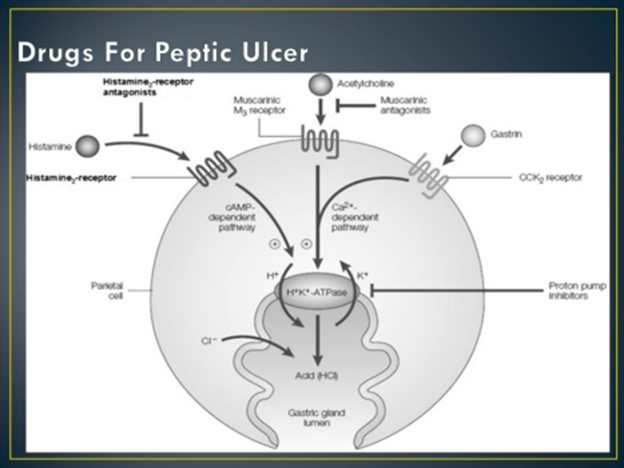A nurse is reinforcing teaching about cimetidine with a client who has peptic ulcer disease. Which of the following information should the nurse include in the teaching?
Expect breast tenderness while taking this medication
Wait at least 1 hr after taking the medication before taking an antacid.
Take ibuprofen for occasional aches and pains
Take this medication on an empty stomach
The Correct Answer is B
Cimetidine is a medication known as a histamine H2 receptor antagonist, commonly used in the treatment of peptic ulcer disease. It works by reducing the production of stomach acid. When teaching a client about cimetidine, it is important to inform them about the timing of taking other medications, specifically antacids.
Antacids, which are used to neutralize stomach acid, can interfere with the absorption of cimetidine if taken simultaneously. Therefore, it is generally recommended to wait at least 1 hour after taking cimetidine before taking an antacid. This allows sufficient time for the cimetidine to be absorbed and start working effectively before neutralizing stomach acid with an antacid.

Nursing Test Bank
Naxlex Comprehensive Predictor Exams
Related Questions
Correct Answer is C
Explanation
Gastroesophageal reflux disease (GERD) is a condition characterized by the backflow of stomach acid into the esophagus, causing symptoms such as heartburn. Orange juice is highly acidic, and consuming acidic foods and beverages can exacerbate the symptoms of GERD. The acidic nature of orange juice can irritate the esophagus and contribute to increased acid reflux, leading to heartburn.
Sleeping on a large wedge-style pillow can actually help alleviate symptoms of GERD by elevating the head and upper body, reducing the likelihood of acid reflux during sleep.
Eating dinner early in the evening is generally recommended for individuals with GERD as it allows sufficient time for digestion before lying down. This can help prevent acid reflux during sleep.
Consuming low-fat meats is also a favorable choice for individuals with GERD as fatty foods can relax the lower esophageal sphincter, allowing stomach acid to flow back into the esophagus. However, the options provided do not include any fatty foods, so it is not the primary contributing factor to the client's heartburn in this case.
Correct Answer is B
Explanation
This statement is incorrect and requires correction because it suggests starting the flow of urine before positioning the collection container, which can result in contamination of the specimen. The correct procedure for collecting a midstream urine specimen involves the following steps:
1. Provide the client with a clean urine specimen container.
2. Instruct the client to cleanse the genital area using a provided towelette or antiseptic wipes, wiping from front to back.
3. Instruct the client to start urinating into the toilet or bedpan.
4. As the urine stream continues, the client should pass the collection container into the stream to collect the midstream specimen.
5. Once an adequate amount of urine has been collected (as per the laboratory's instructions), the client should remove the container from the stream of urine. 6. The client can then complete urinating into the toilet or bedpan.
The other statements made by the newly licensed nurse are correct:
"Use the provided towelette to cleanse the area by moving in a back-and-forth motion": This statement correctly instructs the client to cleanse the genital area before collecting the urine specimen.
"It will be easier to use your nondominant hand to spread the labia": This statement is correct as it suggests using the nondominant hand to facilitate the collection process.
"Remove the specimen container before stopping the stream of urine": This statement is correct as it indicates that the container should be removed before completing urination.
Whether you are a student looking to ace your exams or a practicing nurse seeking to enhance your expertise , our nursing education contents will empower you with the confidence and competence to make a difference in the lives of patients and become a respected leader in the healthcare field.
Visit Naxlex, invest in your future and unlock endless possibilities with our unparalleled nursing education contents today
Report Wrong Answer on the Current Question
Do you disagree with the answer? If yes, what is your expected answer? Explain.
Kindly be descriptive with the issue you are facing.
